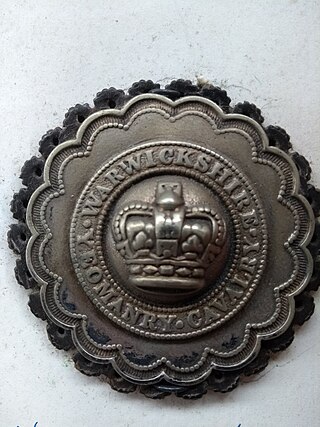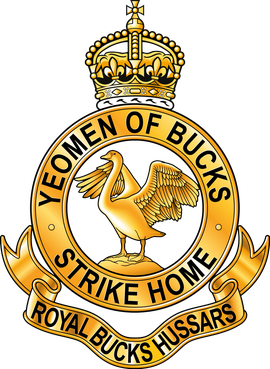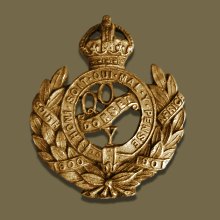
The 1st Cavalry Division was a regular Division of the British Army during the First World War where it fought on the Western Front. During the Second World War it was a first line formation, formed from Yeomanry Regiments. It fought in the Middle East before being converted to the 10th Armoured Division.

The Derbyshire Yeomanry was a yeomanry regiment of the British Army, first raised in 1794, which served as a cavalry regiment and dismounted infantry regiment in the First World War and provided two reconnaissance regiments in the Second World War, before being amalgamated with the Leicestershire Yeomanry to form the Leicestershire and Derbyshire Yeomanry in 1957.

The Warwickshire Yeomanry was a yeomanry regiment of the British Army, first raised in 1794, which served as cavalry and machine gunners in the First World War and as a cavalry and an armoured regiment in the Second World War, before being amalgamated into the Queen's Own Warwickshire and Worcestershire Yeomanry in 1956. The lineage is maintained by B Squadron, part of The Royal Yeomanry.

The South Nottinghamshire Hussars is a unit of the British Army formed as volunteer cavalry in 1794. Converted to artillery in 1922, it presently forms part of 103 Regiment, Royal Artillery.
The 3rd Mounted Division was a Yeomanry Division of the British Army active during World War I. It was formed on 6 March 1915 as the 2/2nd Mounted Division, a replacement/depot formation for the 2nd Mounted Division which was being sent abroad on active service. In March 1916, it was renumbered as the 3rd Mounted Division and in July 1916 as the 1st Mounted Division. In September 1917, the division was reorganized as a cyclist formation and redesignated as The Cyclist Division. It remained in the United Kingdom throughout the war and was disbanded in June 1919.
The 1st Mounted Division was a Yeomanry Division of the British Army active during World War I. It was formed in August 1914 for the home defence of the United Kingdom from four existing mounted brigades of the Territorial Force, each of three regiments of Yeomanry. The divisional order of battle changed often, as the 1st Line brigades left for service overseas and were replaced by 2nd Line formations. It was converted to the 1st Cyclist Division in July 1916, and was broken up in November 1916 without being involved in active service. It remained in East Anglia throughout its existence.

The Royal Buckinghamshire Yeomanry is an Operational Hygiene Squadron of the Royal Logistic Corps, originally formed as cavalry in 1794, and has also served in artillery and signals roles. The lineage is continued by 710 Operational Hygiene Squadron, Royal Logistic Corps.
The Royal East Kent Yeomanry was a British Army regiment formed in 1794. It saw action in the Second Boer War and the First World War.

The Queen's Own West Kent Yeomanry was a British Army regiment formed in 1794. It served in the Second Boer War and the First World War. It amalgamated with the Royal East Kent Yeomanry to form the Kent Yeomanry in 1920.

The Queen's Own Dorset Yeomanry was a yeomanry regiment of the British Army founded in 1794 as the Dorsetshire Regiment of Volunteer Yeomanry Cavalry in response to the growing threat of invasion during the Napoleonic wars. It gained its first royal association in 1833 as The Princess Victoria's Regiment of Dorset Yeomanry Cavalry, and its second, in 1843, as the Queen's Own Regiment of Dorset Yeomanry Cavalry.
The West Somerset Yeomanry was a Yeomanry regiment of the British Army. First raised in 1794, it participated in the Second Boer War and World War I before being converted to an artillery regiment. It served in World War II. Post-war it was gradually reduced in strength until the yeomanry lineage of the successor unit was discontinued on 9 November 1988.
The Royal North Devon Yeomanry was a Yeomanry regiment of the British Army. First raised in 1798, it participated in the Second Boer War and the First World War before being amalgamated with the Royal 1st Devon Yeomanry in 1920 to form the Royal Devon Yeomanry.
The 4th Mounted Division was a short-lived Yeomanry Division of the British Army active during World War I. It was formed on 20 March 1916, converted to 2nd Cyclist Division in July 1916 and broken up on 16 November 1916. It remained in England on Home Defence duties throughout its existence.

The 231st Brigade was an infantry brigade of the British Army that saw active service in both the First and the Second World Wars. In each case it was formed by redesignation of existing formations. In the First World War, it fought in Palestine and on the Western Front, while during the Second World War it served in the Allied invasion of Sicily, Italy and the Normandy landings of 6 June 1944.

The 2nd Dismounted Brigade was a formation of the British Army in the First World War. It was formed in Egypt in February 1916 by absorbing the Highland Mounted Brigade and the 2nd South Western Mounted Brigade. In October it absorbed the remnants of the 1st Dismounted Brigade. The brigade served as part of the Western Frontier Force and the Suez Canal Defences.

The 3rd Dismounted Brigade was a formation of the British Army in the First World War. It was formed in Egypt in February 1916 by absorbing the Eastern Mounted Brigade and the South Eastern Mounted Brigade. The brigade served as part of the Western Frontier Force and the Suez Canal Defences.
The 63rd Division of the British Army was a second-line Territorial Force division, formed in 1914, which served on home defence duties during the First World War. The division was formed as a duplicate of the 50th (Northumbrian) Division in 1914, composed primarily of soldiers recruited in north-eastern England. It remained on home defence and training duties in the north-east and east of England until 1916, when it was disbanded. Several of its constituent units would later serve overseas, deployed for support and garrison duties in almost every theatre of the war.

The British yeomanry during the First World War were part of the British Army reserve Territorial Force. Initially, in 1914, there were fifty-seven regiments and fourteen mounted brigades. Soon after the declaration of war, second and third line regiments were formed. However, the third line regiments were soon absorbed into the Cavalry Reserve Regiments, to supply replacements for the cavalry and yeomanry. Other horsed regiments in the British Army, during the war, were the regular cavalry regiments and the three regiments belonging to the special reserve: the North Irish Horse, the South Irish Horse and the King Edward's Horse. The senior yeomanry regiments could trace their origins back over 100 years; the oldest regiment, the Royal Wiltshire Yeomanry, had been formed in 1794. The most junior regiment, the Welsh Horse, had only been formed on 18 August 1914, after the start of the war.
The Royal 1st Devon Yeomanry was a Yeomanry regiment of the British Army. First raised in 1794, it participated in the Second Boer War and the First World War before being amalgamated with the Royal North Devon Yeomanry in 1920 to form the Royal Devon Yeomanry.
The 17th Mounted Brigade previously known as the 2/1st Welsh Border Mounted Brigade was a 2nd Line yeomanry brigade of the British Army during the First World War. In July 1916 it was converted to a cyclist formation as 10th Cyclist Brigade and in November 1916 was redesignated as 6th Cyclist Brigade. It was still in existence, in Ireland, at the end of the war.










